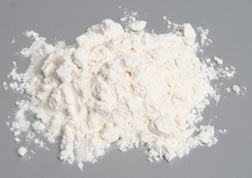|
Commercial Flour Milling
 The wheat flour milling process begins after the wheat is harvested and is delivered to local elevators where it is graded and sold. The wheat is then delivered to the flourmill, where the first step is to remove the dirt and impurities. The wheat kernels pass through a series of rollers and sieves and are thoroughly cleaned. Additional rollers are used to break the kernels to expose the endosperm, which is the portion used for white flour. Another series of rollers crushes the endosperm and a set of sieves removes the residue (chaff) of the kernels. The crushed endosperm is sieved until it is in the form of a fine powder. Rolling and sieving is continued to produce various types and textures of flour. The wheat flour milling process begins after the wheat is harvested and is delivered to local elevators where it is graded and sold. The wheat is then delivered to the flourmill, where the first step is to remove the dirt and impurities. The wheat kernels pass through a series of rollers and sieves and are thoroughly cleaned. Additional rollers are used to break the kernels to expose the endosperm, which is the portion used for white flour. Another series of rollers crushes the endosperm and a set of sieves removes the residue (chaff) of the kernels. The crushed endosperm is sieved until it is in the form of a fine powder. Rolling and sieving is continued to produce various types and textures of flour.
During the early days of commercial flour milling in the United States, wheat was milled with traditional heavy, flat stones (millstones), which were excellent tools for grinding grain, however the flour was usually discolored due to the buildup of heat from the millstones. In addition to this, particles of bran were distributed throughout the flour and the flour did not have a long shelf life.
New techniques were developed that allowed the bran to be separated from the wheat kernel in order to produce cleaner, whiter, and finer textured flour. Chilled rollers, constructed of porcelain or iron, were used to grind the wheat so that heat did not build up. Because the nutrient-rich bran and germ are removed when producing white flour, it is often enriched with vitamins and minerals to replace the missing nutrients.
The use of steel grinding equipment for milling wheat is a common procedure for mills that produce large volumes of flour (known as steel-ground flour) for commercial use and retail sales. The wheat germ and bran are separated from the remaining portion of the kernel automatically, but are returned to the flour later in the milling process to produce the whole-wheat flour. Small quantities of bran and germ may be lost during the process, however when wheat is milled with the traditional method of cold grinding between heavy millstones, no part of the wheat kernel is lost or separated. Many people regard stone ground wheat flour as the most flavorful and nutritious.
Many types of wheat flour are available in bleached and unbleached varieties. Wheat flour becomes white (actually off-white) naturally through oxidation, which in earlier times was the method used by flour millers to create white flour. This eventually became impractical because of the time and space required for large quantities of flour to oxidize naturally so chemical bleaching was developed, which hastens the whitening process. The chemicals used for bleaching flour (usually chlorine, which evaporates after it is added to the flour) act as a preservative so that the flour will not develop an off flavor or spoil after a short period. The chemicals also prevent dough from becoming discolored and provide more consistent results when baking, however the chemicals affect the gluten strength of the flour, therefore bread makers often prefer unbleached flour. | 
